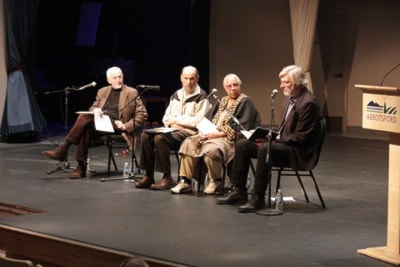More than 150 people came out to a gallery tour and peace symposium at the Reach Gallery Museum in Abbotsford on Feb. 4.
Goya: Conversations on War and Peace, began at noon with a tour of the Goya: the Disasters of War and Los Caprichos exhibit currently showing at the Reach.
Dr. Dorothy Barenscott, an art historian and writer, and Scott Marsden, curator at the Reach, led the tour of the National Gallery of Canada exhibit that is an expose of the atrocities committed against the Spanish people by Napoleon’s armies during the Peninsular War. The tour enabled viewers to learn more about the context of Goya’s work as well as the process of creating his exquisite prints.
“It is a real coup for Abbotsford to get Goya’s sketches from the National Gallery,” said Ed Janzen, who attended the symposium and who leads the Christianity and the Arts group at his church, Emmanuel Mennonite.”
The event continued at the Matsqui Centennial Auditorium where Jon Nofziger, peace and development education coordinator for Mennonite Central Committee BC (MCC BC) introduced the guest speaker.
Dr. Ernie Regher, began with an address on the Nature of War Today. Regher indicated that the second half of the 20th century saw fewer state-to-state wars than the first half and that while civil wars certainly still exist, this is still an achievement.
“We are actually living in the most peaceful time of our history,” he said. “Positive change can happen. To work ceaselessly to prevent war is not idealism and fantasy but an attainable goal.”
Regher’s address was followed by a panel discussion on the Nature of Peace Today. The panel included Regher as well as Dr. Saul Arbess, co-chair of the Department of Peace Initiative and Victoria Marie, a Vancouver-based teacher, researcher and activist. Each speaker gave a different perspective on peace.
Victoria Marie indicated that peace must begin within each person in order to affect positive change outside oneself.
“First we must be a people of peace,” she said, “then we have a place from which to begin.”
The afternoon ended with a conversation between Barenscott and Dick Averns, an artist and writer who has toured with the Canadian Armed Forces, who explored the role of the artist in times of conflict.
“The role of the artist is to draw attention to what is happening, not to give easy answers,” Barenscott said. “During Goya’s time, war was human to human conflict. Today, conflict has become more abstract. It is the same in art, which has gone from a literal expression to an often more abstract expression.”
